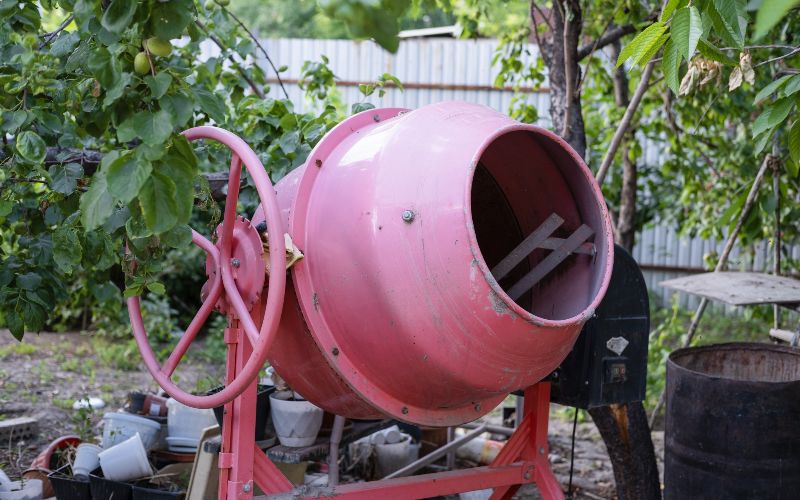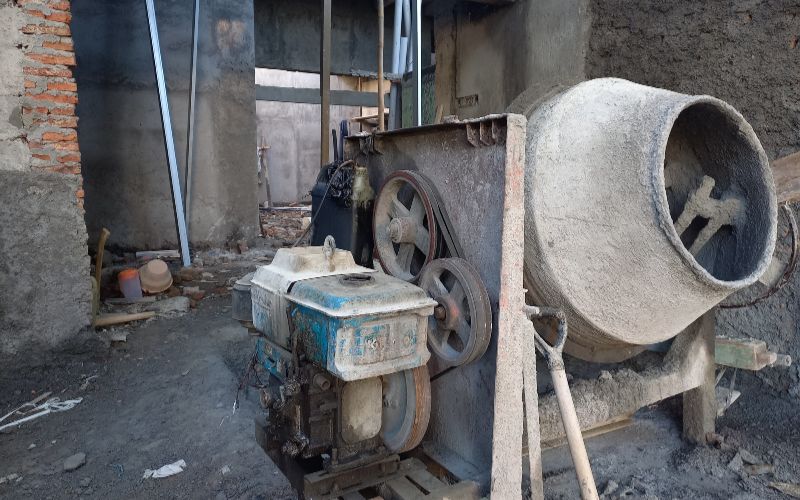Having a quality concrete mixer on site can be somewhat of a crew’s best friend, until the moment that it isn’t. One minute it’s humming along, churning out perfect batches, and the next it’s stalling or even refusing to turn at all. When this happens to your mid-pour, every precious minute counts.
The good news is that most problems with concrete mixers are not completely catastrophic; most of the time, they are simple mechanical issues that can be identified and fixed on-site with a spanner, a little bit of know-how, and preventative maintenance.
In this BS Power guide, we will help you diagnose and solve some of the most common concrete mixer problems quickly and safely, which will ultimately save you time, money, and frustration.
Whether you’re using a 360 L Honda-powered concrete mixer or a larger 400 L Baumax unit, these troubleshooting tips apply across the board. Read on as you’ll learn what to look for, how to fix it, and how to keep your concrete mixer in prime condition for years to come.
Issue 1: Your Concrete Mixer Drum Stopped Turning
This is one of the most prevalent issues. You start up the engine, hear it running fine, but the drum won’t spin. Do not panic, though; this common issue almost always comes down to drive-line wear or even misalignment, and not due to a major failure.
Likely Causes F or The Drum Not Turning
Your concrete mixer refusing to turn can be due to a number of causes. Firstly, it could be a loose or worn belt, as over time, drive belts can stretch and slip off under load. It could also be that the chain is too slack or even broken. Basically, the chain that links the drum to the motor sprocket can lose tension. And lastly, the engine coupling might be misaligned if the engine has shifted on its mountings, which can happen in transit or because of rough use, and thus the coupling can’t transmit power efficiently.
Quick Fixes For A Drum That Won’t Turn
Inspect the tension of the belt. A healthy mixer belt should deflect around 10-14 mm when you press it midway. If you find it’s too loose, simply adjust the tensioner or replace the belt.
Check the tension of the chain and lubrication. Any contractor knows that a dry or rusty chain increases friction, so simply apply some light oil or grease weekly to avoid this from happening.
Re-align the engine mount. Start by loosening the bolts slightly, repositioning for proper pulley alignment, and then tighten evenly.
BS Power Pro Tip: Overloading a concrete mixer drum dramatically increases the chance of belt and chain wear. Even a mixer of 400 L, like the Honda models we stock, should only run around 200 L of mixed materials at a time for optimal performance.
Issue 2: The Engine Starts But Stalls After A Few Seconds.
There are a few things that truly test one’s patience, like a concrete mixer that starts up with ease, only to die within ten seconds. Your crew is ready to work, and the clock is ticking; this little hiccup can cost you hours. Luckily, it’s usually always a fuel, air, or oil-related issue as opposed to full-blown engine failure.
Likely Causes For The Engine Stalling
It could be a clogged fuel system, as dust and cement fines can easily find their way into your mixer’s tank or filter. Even the smallest blockage can restrict enough flow to make your engine stall under load. Secondly, it could be a low-oil sensor cut-off, for example, the Honda GX models come with a safety switch that automatically kills ignition when the oil level drops below the minimum mark.
It might also be a choked air filter, as cement dust can coat the paper filters quickly, which will starve your carburettor of air. And lastly, it could even be due to stale or contaminated fuel, as after storage for long periods, the petrol can oxidise and gum your jets and valves.

Quick Fixes For A Stalling Engine
First up, check your oil. Then top up to the very upper dipstick line using SAE 10W-30 before repeated starts. Next, drain the old fuel, and refill with clean petrol from a sealed container.
Now, remove and gently tap the air filter to release any dust, and replace it if visibly grey or damp.
Inspect your fuel line and the filter bowl, and clear any sediment or replace the inline filter completely.
If the problem persists, then unscrew and clean the carburettor jet using a fine copper wire, and NEVER steel.
BS Power Bonus Preventative Tip
Ensure that you keep your concrete mixer covered when not in use and run your engine dry after each job to prevent residue from building up. Conducting a quick five-minute check every day before work can save you money from potential breakdowns mid-pour.
Issue 3: Your Concrete Mixer Produces Uneven Or Dry Mixes
When your batches come out all patchy, with one load maybe being too stiff and another soupy, you’re not only wasting raw materials, but also risking structural weakness and costly reworks. Any concrete mixer that is delivering inconsistent results is more than likely battling with one of three problems: poor ratios, worn blades, or erratic drum speeds.
Likely Causes Of Dry Or Uneven Mixes
Firstly, it could be due to incorrect batching sequencing, i.e. adding cement last or water first can trap dry pockets along the walls of the drum. It can also be due to worn or bent mixing paddles, as rounded edges will stop the paddles from folding the materials evenly through the mix.
Third, it could be due to uneven drum rotation; for example, a slipping belt or low-power drive can reduce RPMs, which will leave clumps of aggregate unmixed.
Quick Fixes For Dry And Uneven Mixes
Re-establishing the correct loading order: Always add ½ water first, then aggregate, then cement, and finish the rest with water. This sequence will coat each particle and prevent balling.
Next, the paddle condition. Turn the power off, inspect through the hatch, and replace any blades that are visibly warped or thin, as worn paddles can reduce the mixer’s mixing efficiency by 30%.
Verify the tension of the belt next, as a slack belt can drop your drum speed from 25 rpm to 15 rpm, which will produce an under-mixed and dry load.
Always stay within the rated volume. For instance, a 400 L mixer should yield around 200 L of mixed concrete per batch, and anything more can risk uneven texture.
BS Power Quality Control Tip
Before every pour, we suggest running a short test batch using a 1:2:3 cement-sand-stone ratio with measured water (≈ 60–65 L per 400 L drum). If the mix feels dry, please resist the temptation to add water blindly and check the rotation speed and condition of the paddles first.

Issue 4: Excessive Noise Or Vibrations
A concrete mixer that rumbles a little bit is normal; these machines are not meant to whisper, but if yours suddenly sounds like a jackhammer or even rattles across the slab, you need to act fast. Any excess vibrations or noise are definite early warning signs of potential mechanical imbalances, or even component wear and tear, and if you ignore them, you can shorten the lifespan of your mixer dramatically.
Likely Causes Of Excessive Vibration Or Noise
It could be due to loosen bolts or frame connections, as continuous vibration can even loosen the locknuts, especially around the drum and motor mounts. Worn bearings could also be the root cause, as grinding or whining noises commonly indicate that the drum bearings are running dry or starting to seize.
Another cause could be damaged ring gear teeth, as rhythmic clunking or scraping indicates chipped or misaligned gear teeth. Lastly, it could also be due to uneven loads; if you mix heavy on one side of the drum, this will throw the balance off, which will put unnecessary stress on the drive system.
Quick Fixes For Excessive Noise Or Vibrating
Tighten all the mounting bolts. Start by doing the drum supports, the base of the motor, and do this using a torque wrench wherever possible. Ensure that you tighten in a cross pattern to make sure you distribute the pressure evenly.
Check the bearing condition, do this by turning the drum manually (engine off), and if you feel any grinding or resistance, then the bearings more than likely need cleaning, greasing or even replacement.
Inspect the ring gear. Start by looking for any missing or worn teeth. Damaged gears can easily be replaced. Balance your loads. Ensure that you always fill evenly and avoid overloading one side of the drum by using consistent shovel counts per batch.
BS Power Bonus Tip
Make sure that you apply fresh grease to your drum bearings at least once per week by using a lithium-based compound, especially if you’re working on very dusty sites. For the ring gears, wipe away any cement residue and then reapply a light oil film to prevent metal-on-metal wear.

Keep Your Mixer Turning And Your Jobs On Track With BS Power
Ask any contractor, here in SA, and anywhere else in the world, when your mixer goes down on site, the entire job slows down. But as you’ve read now, most issues aren’t complete disasters; they’re merely the result of wear, dirt, or simple neglect. A few minutes of maintenance and simple troubleshooting can save you hours of costly downtime, prevent expensive repairs, and keep your crew working optimally.
Here in South Africa, regular cleaning, greasing, and inspections are small and vital habits that pay off big, especially in our nation, where dust, heat, and humidity can push your tools to their limit. But if you keep your belts tight, your bearings lubricated, and your loads balanced, you can extend the lifespan of your mixer and improve the quality of every pour.
BS Power has your back when you might need help, from our range of 360 L Honda-powered models to the 400 L Baumax workhorses, our mixers have been engineered for tough, extended, and everyday use, and our aftersales team provides the parts, servicing, and support to match. So don’t let minor mechanical issues stop your momentum. Invest in quality tools, maintain them properly, and your concrete mixer will help with your dividends for years to come.
Always keep a laminated checklist on every job site, conduct daily oil checks, weekly greasing, and monthly paddle checks. A simple five-minute routine can save you thousands in lost labour.
To view our full range of high-quality concrete mixers, simply head over to the main BS Power website.






